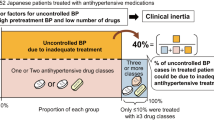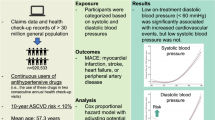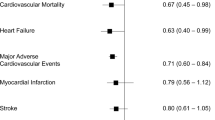Abstract
It is well established that there is a continuous relationship between raised blood pressure and the risk of cardiovascular or cerebrovascular disease. Both systolic and diastolic hypertension are associated with increased risk, but systolic blood pressure appears to be a more important determinant of risk than diastolic blood pressure. Randomised controlled trials have clearly shown that lowering blood pressure results in significant reductions in cardiovascular mortality and morbidity, and hence current hypertension management guidelines recommend target blood pressures of below 140/90 mm Hg (135/85 mm Hg in the case of the WHO/ISH guidelines). Despite the clear evidence for the benefits of antihypertensive therapy, however, blood pressure is often not adequately controlled in clinical practice. Population surveys indicate that the proportion of patients achieving even conservative blood pressure targets may be only 20% or lower. A number of factors contribute to poor control of hypertension, including a focus by the physician on diastolic blood pressure, rather than the prognostically more important systolic pressure, and poor adherence to therapy by patients. Poor adherence may be largely attributable to adverse events, and there is evidence that the excellent tolerability profile of angiotensin II type 1 (AT1)-receptor blockers may help to increase the proportion of patients remaining on therapy. AT1-receptor blockers could thus make a potentially important contribution to solving the problem of uncontrolled hypertension.
This is a preview of subscription content, access via your institution
Access options
Subscribe to this journal
Receive 12 digital issues and online access to articles
$119.00 per year
only $9.92 per issue
Buy this article
- Purchase on Springer Link
- Instant access to full article PDF
Prices may be subject to local taxes which are calculated during checkout





Similar content being viewed by others
References
MacMahon S et al. Blood pressure, stroke and coronary heart disease. Part 1, Prolonged differences in blood pressure: prospective observational studies corrected for the regression dilution bias Lancet 1990 335: 765–774
Collins R et al. Blood pressure, stroke and coronary heart disease. Part 2, Short-term reductions in blood pressure: overview of randomised drug trials in their epidemiological context Lancet 1990 335: 827–838
Guidelines Subcommittee. 1999 World Health Organization – International Society of Hypertension. Guidelines for the management of hypertension J Hypertens 1999 17: 151–183
Stamler J, Stamler R, Neaton JD . Blood pressure, systolic and diastolic, and cardiovascular risks. US population data Arch Intern Med 1993 153: 598–615
Staessen JA et al. Risks of untreated and treated isolated systolic hypertension in the elderly: meta-analysis of outcome trials Lancet 2000 355: 865–872
Du X et al. Case-control study of stroke and the quality of hypertension control in north west England Br Med J 1997 314: 272–276
MacMahon S, Rodgers A . The effects of antihypertensive treatment on vascular disease: reappraisal of the evidence in 1994 J Vasc Biol Med 1993 4: 265–271
Isles CG et al. Mortality inpatients of the Glasgow Blood Pressure Clinic J Hypertens 1986 4: 141–156
Hansson L et al. Randomised trial of old and new antihypertensive drugs in elderlypatients: cardiovascular mortality and morbidity the Swedish Trial in Old Patients with Hypertension-2 study Lancet 1999 354: 1751–1756
Dahlöf B et al. Morbidity and mortality in the Swedish Trial in Old Patients with Hypertension (STOP-Hypertension) Lancet 1991 338: 1281–1285
Lindholm LH et al. Relation between drug treatment and cancer in hypertensives in the Swedish Trial in Old Patients with Hypertension 2: a 5-year, prospective, randomised, controlled trial Lancet 2001 358: 539–544
Pahor M et al. Do calcium channel blockers increase the risk of cancer? Am J Hypertens 1996 9: 695–699
Pahor M et al. Calcium-channel blockade and incidence of cancer in aged populations Lancet 1996 348: 493–497
UK Prospective Diabetes Study Group. Tight blood pressure control and risk of macrovascular and microvascular complications in type 2 diabetes: UKPDS 38 Br Med J 1998 317: 703–713
Mancia G, Grassi G . Rationale for the use of a fixed combination in the treatment of hypertension Eur Heart J 1999 1 (Suppl L): L14–L19
Primatesta P, Brookes M, Poulter NR . Improved hypertension management and control. Results form the Health Survey for England 1998 Hypertension 2001 38: 827–832
Perry HM Jr et al. Antihypertensive efficacy of treatment regimens used in Veterans Administration hypertension clinics. Department of Veterans Affairs Cooperative Study Group on Antihypertensive Agents Hypertension 1998 31: 771–779
Swales JD . Current clinical practice in hypertension: the EISBERG (Evaluation and Interventions for Systolic Blood pressure Elevation – Regional and Global) project Am Heart J 1999 138: S231–S237
Joint National Committee. Sixth National Report of the Joint National Committee on Prevention, Detection, Evaluation and Treatment of High Blood Pressure (JNC VI) Arch Intern Med 1997 157: 2413–2446
Hansson L et al. Effects of intensive blood-pressure lowering and low-dose aspirin inpatients with hypertension: principal results of the Hypertension Optimal Treatment (HOT) randomised trial Lancet 1998 351: 1755–1762
Jones JK et al. Discontinuation of and changes in treatment after start of new courses of antihypertensive drugs: a study of a United Kingdom population Br Med J 1995 311: 293–295
Hosie J, Wiklund I . Managing hypertension in general practice: can we do better? J Hum Hypertens 1995 9 (Suppl 2): S15–S18
Bloom BS . Continuation of initial antihypertensive medication after one year of therapy Clin Ther 1998 20: 671–681
Chaput AJ . Persistency with angiotensin receptor blockers (ARB) versus other antihypertensives (AHT) using the Saskatchewan database Can J Cardiol 2000 16 (Suppl F): 194F (abstract 390)
Elmfeldt D, George M, Hübner R, Olofsson B . Candesartan cilexetil, a new generation angiotensin II antagonist, provides dose dependent antihypertensive effect J Hum Hypertens 1997 11 (Suppl 2): S49–S53
Author information
Authors and Affiliations
Corresponding author
Rights and permissions
About this article
Cite this article
Lindholm, L. The problem of uncontrolled hypertension. J Hum Hypertens 16 (Suppl 3), S3–S8 (2002). https://doi.org/10.1038/sj.jhh.1001433
Published:
Issue Date:
DOI: https://doi.org/10.1038/sj.jhh.1001433
Keywords
This article is cited by
-
Major inducing factors of hypertensive complications and the interventions required to reduce their prevalence: an epidemiological study of hypertension in a rural population in China
BMC Public Health (2011)
-
Accumulation of 30 min of moderately intense physical activity is a clinically meaningful treatment to reduce systolic blood pressure in prehypertension
Journal of Human Hypertension (2008)
-
Does it matter whether patients take their antihypertensive medication as prescribed? The complex relationship between adherence and blood pressure control
Journal of Human Hypertension (2006)
-
Efficacy and safety of combination therapy using high- or low-dose hydrochlorothiazide with valsartan or other angiotensin-receptor blockers
Advances in Therapy (2005)



